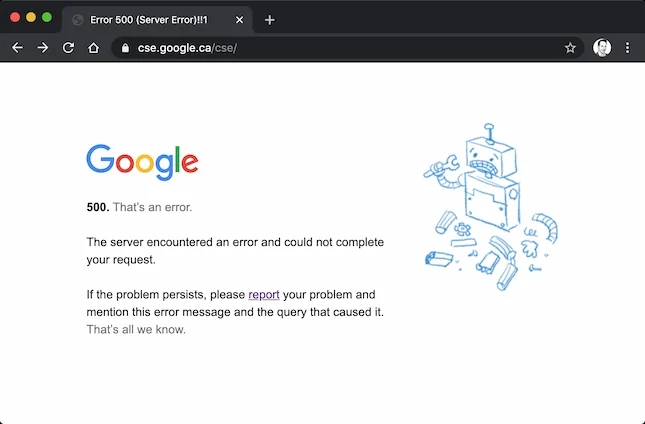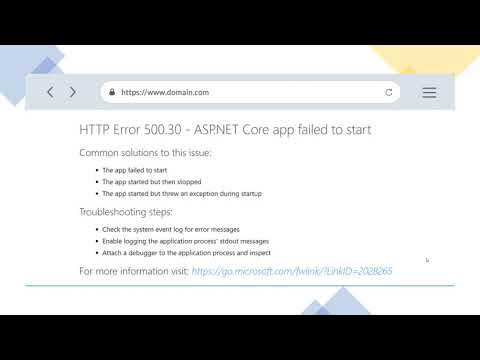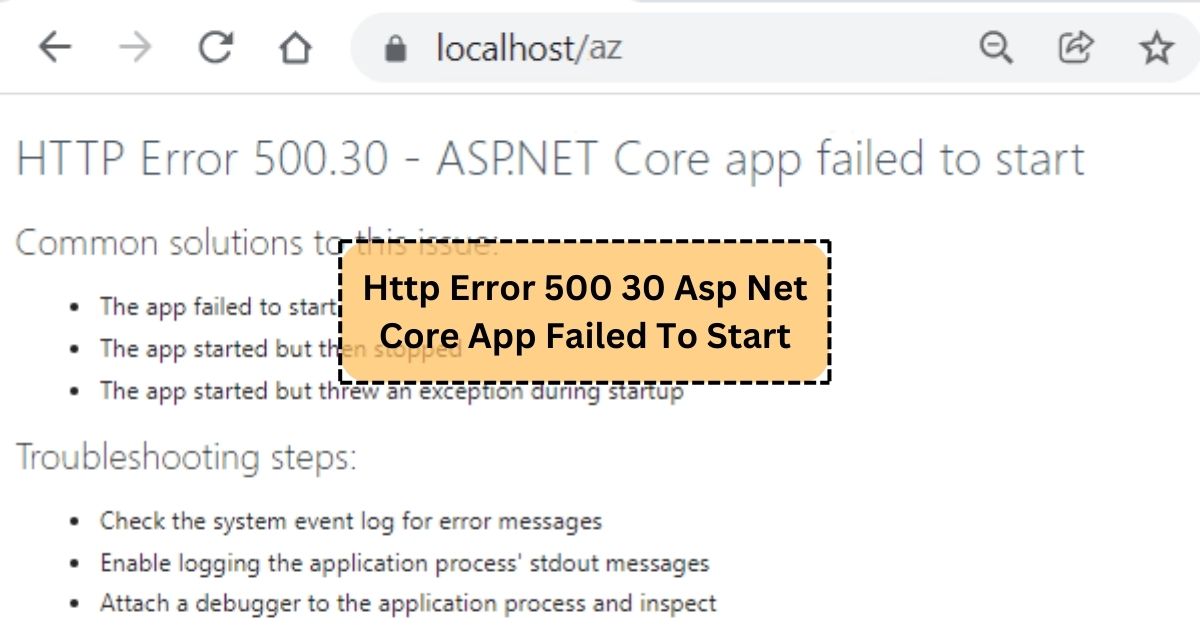Stepping into the realm of web development, HTTP Error 500 30 emerged as an unexpected challenge, casting a shadow on the seamless progression of my project. This cryptic error disrupted the flow of my ASP.NET Core application and sparked a journey of exploration and problem-solving.
HTTP Error 500 30, often daunting for developers, signifies an ASP.NET Core app startup failure. This guide demystifies the error with user-friendly solutions, making troubleshooting smoother for developers.
In this article, we’ll dive into understanding and solving HTTP Error 500.30, simplifying the troubleshooting process for a smoother developer experience.
What Is Http Error 500 30 – Unveiling The Mystery!
HTTP Error 500.30, commonly known as the ‘ASP.NET Core app failed to start,’ occurs when an unexpected issue prevents an ASP.NET Core application from initialising correctly. It signals that something within the application’s setup has gone awry, hindering its ability to respond to requests.
The error’s elusive nature demands a meticulous approach for effective troubleshooting, as it could stem from various sources like outdated .NET Core components, misconfigurations, or file permission problems.
Resolving HTTP Error 500.30 involves a systematic process, including debugging, checking application settings, and updating essential components like the .NET Core Hosting Bundle. Understanding the root causes and implementing user-friendly solutions is crucial for developers navigating this challenging terrain in web development.

Why Does HTTP Error 500 30 Happen – Explore Now!
Imagine your application as a car embarking on a journey, facing potential roadblocks like:
1. Outdated .NET Core Hosting Bundle:
Ensuring your .NET Core Hosting Bundle is up-to-date is like giving your application a powerful engine upgrade, enhancing its compatibility and performance on the ASP.NET Core highway. Just as a well-maintained engine propels a car forward smoothly, an updated Hosting Bundle fuels your app’s seamless navigation through the digital landscape.
2. Outdated .NET Core SDK and Runtime:
Updating the .NET Core SDK and Runtime is akin to providing your application with the freshest fuel, ensuring it has the latest tools and resources to run at its best. Just as a car performs optimally with top-tier fuel, your app’s functionality flourishes with the most recent SDK and Runtime, unlocking enhanced features and performance.
3. Misconfigured App Settings:
Navigating through the digital landscape, misconfigured app settings serve as the GPS for your application. Like an accurate navigation system ensures the right path, correctly configured settings guide your app, preventing it from veering off course into potential issues.
4. Incorrect Hosting Model:
Opting for the incorrect hosting model is comparable to attempting to fit a square peg into a round hole, a mismatch that inevitably leads to incompatibility. Just as a square peg doesn’t align with a round hole, choosing the right hosting model ensures a seamless and suitable environment for your application to thrive.
5. Web.Config File Issues:
Consider the web. Config file as your application’s manual, guiding its behaviour. Any hitches in this manual, akin to errors or misconfigurations, can steer your app off course, emphasising the importance of a well-maintained and error-free configuration.
6. File Permission Problems:
File permission problems create a scenario where your app is akin to a car without the necessary fuel access. Just as a car can’t go far without fuel, your application’s progress is hindered when it lacks the proper permissions to access essential files.
7. Missing or Outdated Dependencies:
In the digital realm, your app resembles a superhero team, facing challenges if one crucial member, like a dependency, is either missing or outdated. Like a superhero team losing its strength without every member, your app’s functionality may falter when essential dependencies aren’t current.
8. Startup File Inconsistencies:
Imagine the startup file as the team captain for your app. If it encounters inconsistencies, it’s like the captain losing direction, potentially causing the entire team your application to veer off course. Ensuring a steadfast startup file is crucial for guiding your app seamlessly through its journey.
9. Database Connection Problems:
Picture your app’s connection to the database as the lifeline to a team. When this connection is broken, it’s comparable to losing contact with crucial team members. Just as a team needs smooth communication, your app thrives when it maintains a seamless connection to its database.
Also read: Trixie Tongue Tricks – An In-Depth Guide To Entertaining!
Precautions Before Troubleshooting – Secure Your Progress!
Before diving into troubleshooting, it’s crucial to take some precautions to ensure a smooth and secure process:
- Backup Your Work: Consider this like saving your progress in a game. Back up your application and data to prevent any accidental losses during troubleshooting.
- Test in a Safe Environment: Just as you’d practice a dance routine before a performance, troubleshoot in a test or development environment first. This helps avoid unexpected disruptions in the live or production environment.
These simple precautions act as your safety net, ensuring that you can explore solutions without risking your work or causing disturbances to your application’s operation.

Diagnosing The Error – Unraveling the Problem!
When faced with an error like HTTP Error 500.30, the key lies in a systematic diagnosis to unravel its complexities:
1. Debugging:
Debugging is your digital detective work, where the Command Prompt serves as your investigation headquarters. By running the application, you collect evidence in error messages, akin to solving a mystery and gaining insights into the issues causing the error. This meticulous process helps unveil the hidden aspects of your application’s behavior, guiding you toward practical solutions.
2. Troubleshooting in Azure:
Troubleshooting in Azure is akin to a digital exploration. Navigate to the console, manually initiate your application, and unveil a potential treasure trove of errors or exceptions. These clues act as beacons, guiding you towards unraveling the mystery behind the mistake and paving the way for practical solutions.
3. Using Event Viewer:
Using Event Viewer is comparable to examining the black box of your application. Inspect the “Windows Logs” for error-level warnings, like reviewing a plane’s flight data after landing. This process offers a detailed account of your app’s behaviour, aiding in understanding and addressing the issues causing the error.
How To Fix HTTP Error 500.30 – Easy Steps!
- Update .NET Core Hosting Bundle: Install or repair the .NET Core Hosting Bundle, ensuring compatibility with ASP.NET Core.
- Update .NET Core SDK and Runtime: Download and install the latest stable release for the .NET version your app is built on.
- Check App Settings: Validate the correctness of your app’s settings in the appsettings.json file, paying attention to connection strings and URLs.
- Troubleshoot Web.Config File: Ensure your web. Config file is configured correctly, checking for missing or incorrect settings.
- Verify File Permissions: Right-click on your project folder, go to “Properties,” and confirm that your app has the necessary permissions.
- Ensure Dependencies are Up-to-Date: In Visual Studio, check the “Dependencies” node to verify and update any missing or outdated packages.
- Run the App Locally: Test your app locally to identify issues that may not surface in a server environment.
- Utilise ASP.NET Core Logging: Enable logging to gain insights into your app’s behaviour, assisting in pinpointing the root cause.
- Review the Startup File: Examine the Startup.cs file for errors or misconfigurations, vital in initialising the app.
- Check Database Connections: Confirm your database connection settings are correct, preventing startup failures.
- Verify Application Pool Settings: Review and adjust application pool settings if necessary in IIS Manager, ensuring smooth app execution.
Remember, troubleshooting is a process of elimination, and by systematically addressing these areas, you can efficiently resolve HTTP Error 500.30.

Frequently Asked Questions:
1. Why is updating the .NET Core Hosting Bundle important?
The Hosting Bundle includes essential components for running ASP.NET Core applications in IIS. Updating ensures compatibility and seamless execution.
2. What role does the Startup file play in resolving HTTP Error 500.30?
The Startup. cs file configures and initialises the application. Errors or misconfigurations in this file can lead to the HTTP Error 500.30, making its review crucial.
3. How can I ensure smooth database connections to avoid HTTP Error 500.30?
Confirm the correct database connection settings in your application. Incorrect configurations can impede the startup process, triggering the error.
4. Can incorrect hosting models lead to HTTP Error 500.30?
Choosing the wrong hosting model is like fitting a square peg into a round hole. It can result in compatibility issues and trigger the error.
Conclusion:
Fixing HTTP Error 500.30 means carefully finding and solving problems, updating essential parts, and ensuring everything works smoothly for your app to run without trouble.
Read more:

























+ There are no comments
Add yours